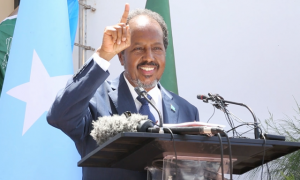
Mogadishu, 27 January 2016: Somalis are an oft-discussed group in Maine. Beginning in 2001, a wave of Somali refugees, primarily from other states, moved to Maine and settled in Lewiston and Portland. They are still arriving as well, with 148 refugees coming into the state directly from abroad in fiscal year 2014. That they are refugees is well-known, but less well-known is what they are actually taking refuge from. For most Mainers, like most Americans, the primary source of information on the Somali Civil War is probably Black Hawk Down, a movie depicting events that occurred in 1993. But the conflict has changed significantly in the 23 years since then.
This is the history of the conflict in Somalia in a nutshell:
It has mutated from a civil war in the 1980s, through state collapse, clan factionalism and warlordism in the 1990s, to a globalized ideological conflict in the first decade of the new millennium.
Over a period of four years beginning in 1986, there was a jockeying for power in the national government as the dictator, Mohamed Siad Barre, was in failing health. Unrest increased throughout the country and eventually the anti-government forces picked up arms and coalesced into multiple rebel groups. One of these organizations, the United Somali Congress, toppled the ruling regime in December 1990, but the numerous other rebel groups, each with their own territory, refused to cooperate with them. What ensued was a war between and within factions primarily defined by clan, multiple parallel peace and reconciliation and transitional government attempts, numerous interventions by other countries, regional organizations, and the UN, and ultimately the death of hundreds of thousands of Somalis over a decade and a half.
This was the period that the events of Black Hawk Down occurred in. The two Black Hawk helicopters shot down in Mogadishu in 1993 were part of a U.S. military task force under the umbrella of the UN peacekeeping and humanitarian mission in Somalia that spanned from 1992 to 1995. The mission started when a drought compounded by the conflict created a famine in the early ‘90s, and it ended when it became clear that the warring groups weren’t going to make peace anytime soon.
The UN mission created a relative lull in violence that continued after their departure, but the country was still far from peaceful. As the conflict continued, other actors got more involved, particularly Ethiopia, Djibouti, and the Arab League. Through various peacemaking efforts by these groups (sometimes competing with one another), the warring factions consolidated somewhat into a transitional government in the early 2000s, although insecurity still reigned.
A distinct turn in the nature of the conflict came in 2006. In April of that year, a group known as the Islamic Courts Union (ICU) took over Mogadishu from a group of warlords that were backed by the U.S. Unlike the failing transitional government of the time, the ICU managed to provide services and brought a brief period of peace to the city. By the end of 2006, they controlled most of southern Somalia. When a mediation attempt failed to reconcile the ICU with the transitional government, Ethiopian forces entered Somalia, forced out the ICU, and put the transitional government back into power in Mogadishu. The ICU splintered after it lost its territory, with one of the offshoots becoming the now infamous Al Shabaab militant group, which pledged allegiance to Al Qaeda in 2012. The heart of the ICU fled to Eritrea and established another group, the Alliance for the Re-liberation of Somali (ARS). In their absence, and with a weak transitional government in place, Al Shabaab was able to take over large swaths of territory.
The following two years were disastrous for the country, as an increase in violence paired with another massive food crisis. But the breaking off of the violent jihadist members of the ICU in 2006 turned out to be key for later reconciliation. In 2008 a deal was forged between the ARS and the transitional government that amounted to a power-sharing agreement. In 2012 a parliament was sworn in (not elected by popular vote, but chosen by “clan elders”) and formed a national government, the first the country had seen in over twenty years. The government was able to consolidate its hold on the country and take back some of the territory held by Al Shabaab. The group was increasingly relegated to resembling an insurgency, far from its prior status ruling most of the southern part of the country, including Mogadishu. Somalia still faces a prolonged fight with Al Shabaab and has a long way to go to create an effective government, but the country may be on a path to peace for the first time in decades.
As would be expected, the protracted conflict displaced hundreds of thousands of people:

Source: UN.
As of the December 2015, there were 892,960 people displaced within the country and 982,534 people who had taken refuge internationally registered with the UN High Commissioner for Refugees. Combined, this represents about 18% of Somalia’s estimated total population of 10.6 million. The majority of the international refugees are in Kenya (419,618), Yemen (253,215), and Ethiopia (251,797). Almost all are in refugee camps, one of which, Dadaab in Kenya, is the largest in the world and a city unto its own with 331,404 people. Relatively few of these refugees have made it to the U.S. There is no readily available data on year-by-year refugee arrivals from Somali since the war started, but the total estimated Somali-born population in the U.S. was only about 76,000 in 2012, although that number has grown. A roughly steady stream of refugees came into the country since the beginning of the war until an uptick in 2004 and another from 2012 onward.
Somalia is still far from being a stable, peaceful country, but it seems to be heading in the right direction. Of course, even if Somalia were to rid itself of violence tomorrow, it would take many years to resettle the nearly one million refugees living in camps. And in those intervening years, many will still head for the U.S and Maine. As more refugees and asylum seekers arrive (and continue to crop up in political conversation), it is good to be equipped with a little bit of knowledge of where they are coming from.
Source: MaineMeetsWorld
_____________________________________________________________________________________Xafiiska Wararka Qaranimo Online | Mogadishu, Somalia
_____________________________________________________________________________________Advertisement
_____________________________________________________________________________________






